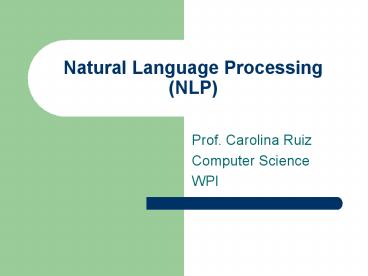Natural Language Processing (NLP) PowerPoint PPT Presentation
Title: Natural Language Processing (NLP)
1
Natural Language Processing (NLP)
- Prof. Carolina Ruiz
- Computer Science
- WPI
2
References
- The essence of Artificial Intelligence
- By A. Cawsey
- Prentice Hall Europe 1998
- Artificial Intelligence Theory and Practice
- By T. Dean, J. Allen, and Y. Aloimonos.
- The Benjamin/Cummings Publishing Company, 1995
- Artificial Intelligence
- By P. Winston
- Addison Wesley, 1992
- Artificial Intelligence A Modern Approach
- By Russell and Norvig
- Prentice Hall, 2003
3
Communication Typical communication episodeS
(speaker) wants to convey P (proposition) to H
(hearer) using W (words in a formal or natural
language)
- 1. Speaker
- Intention S wants H to believe P
- Generation S chooses words W
- Synthesis S utters words W
- 2. Hearer
- Perception H perceives words W (ideally W W)
- Analysis H infers possible meanings P1,P2,,Pn
for W - Disambiguation H infers that S intended to
convey Pi (ideally PiP) - Incorporation H decides to believe or disbelieve
Pi
4
Natural Language Processing (NLP)
- Natural Language Understanding
- Taking some spoken/typed sentence and working out
what it means - Natural Language Generation
- Taking some formal representation of what you
want to say and working out a way to express it
in a natural (human) language (e.g., English)
5
Applications of Nat. Lang. Processing
- Machine Translation
- Database Access
- Information Retrieval
- Selecting from a set of documents the ones that
are relevant to a query - Text Categorization
- Sorting text into fixed topic categories
- Extracting data from text
- Converting unstructured text into structure data
- Spoken language control systems
- Spelling and grammar checkers
6
Natural language understanding
- Raw speech signal
- Speech recognition
- Sequence of words spoken
- Syntactic analysis using knowledge of the grammar
- Structure of the sentence
- Semantic analysis using info. about meaning of
words - Partial representation of meaning of sentence
- Pragmatic analysis using info. about context
- Final representation of meaning of sentence
7
Natural Language Understanding
- Input/Output data Processing stage Other
data used - Frequency spectrogram freq. of diff.
- speech
recognition sounds - Word sequence grammar of
- He loves Mary syntactic
analysis language - Sentence structure meanings of
- semantic analysis words
- He loves Mary
- Partial Meaning context of
- ?x loves(x,mary) pragmatics uttera
nce - Sentence meaning
- loves(john,mary)
8
Speech Recognition (1 of 3)
Input Analog Signal
Freq. spectrogram (microphone records voice)
(e.g. Fourier
transform)
Hz
time
9
Speech Recognition (2 of 3)
- Frequency spectrogram
- Basic sounds in the signal (40-50 phonemes)
(e.g. a in cat) - Template matching against db of phonemes
- Using dynamic time warping (speech speed)
- Constructing words from phonemes
(e.g. thingthing) - Unreliable/probabilistic phonemes (e.g. th
50, f 30, ) - Non-unique pronunciations (e.g. tomato),
- statistics of transitions phonemes/words (hidden
Markov models) - Words
10
Speech Recognition - Complications
- No simple mapping between sounds and words
- Variance in pronunciation due to gender, dialect,
- Restriction to handle just one speaker
- Same sound corresponding to diff. words
- e.g. bear, bare
- Finding gaps between words
- how to recognize speech
- how to wreck a nice beach
- Noise
11
Syntactic Analysis
- Rules of syntax (grammar) specify the possible
organization of words in sentences and allows us
to determine sentences structure(s) - John saw Mary with a telescope
- John saw (Mary with a telescope)
- John (saw Mary with a telescope)
- Parsing given a sentence and a grammar
- Checks that the sentence is correct according
with the grammar and if so returns a parse tree
representing the structure of the sentence
12
Syntactic Analysis - Grammar
- sentence -gt noun_phrase, verb_phrase
- noun_phrase -gt proper_noun
- noun_phrase -gt determiner, noun
- verb_phrase -gt verb, noun_phrase
- proper_noun -gt mary
- noun -gt apple
- verb -gt ate
- determiner -gt the
13
Syntactic Analysis - Parsing
- sentence
- noun_phrase verb_phrase
- proper_noun verb
noun_phrase -
determiner noun - Mary ate
the apple
14
Syntactic Analysis Complications (1)
- Number (singular vs. plural) and gender
- sentence-gt noun_phrase(n),verb_phrase(n)
- proper_noun(s) -gt mary
- noun(p) -gt apples
- Adjective
- noun_phrase-gt determiner,adjectives,noun
- adjectives-gt adjective, adjectives
- adjective-gtferocious
- Adverbs,
15
Syntactic Analysis Complications (2)
- Handling ambiguity
- Syntactic ambiguity fruit flies like a banana
- Having to parse syntactically incorrect sentences
16
Semantic Analysis
- Generates (partial) meaning/representation of the
sentence from its syntactic structure(s) - Compositional semantics meaning of the sentence
from the meaning of its parts - Sentence A tall man likes Mary
- Representation ?x man(x) tall(x)
likes(x,mary) - Grammar Semantics
- Sentence (Smeaning)-gt noun_phrase(NPmeaning),verb_
phrase(VPmeaning), combine(NPmeaning,VPmeaning,Sme
aning)
17
Semantic Analysis Complications
- Handling ambiguity
- Semantic ambiguity I saw the prudential
building flying into Boston
18
Pragmatics
- Uses context of utterance
- Where, by who, to whom, why, when it was said
- Intentions inform, request, promise, criticize,
- Handling Pronouns
- Mary eats apples. She likes them.
- SheMary, themapples.
- Handling ambiguity
- Pragmatic ambiguity youre late Whats the
speakers intention informing or criticizing?
19
Natural Language Generation
- Talking back! ?
- What to say or text planning
- flight(AA,london,boston,560,2pm),
- flight(BA,london,boston,640,10am),
- How to say it
- There are two flights from London to Boston. The
first one is with American Airlines, leaves at 2
pm, and costs 560 - Speech synthesis
- Simple Human recordings of basic templates
- More complex string together phonemes in
phonetic spelling of each word - Difficult due to stress, intonation, timing,
liaisons between words

